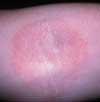- Clinical Technology
- Adult Immunization
- Hepatology
- Pediatric Immunization
- Screening
- Psychiatry
- Allergy
- Women's Health
- Cardiology
- Pediatrics
- Dermatology
- Endocrinology
- Pain Management
- Gastroenterology
- Infectious Disease
- Obesity Medicine
- Rheumatology
- Nephrology
- Neurology
- Pulmonology
Actinic Granuloma and Atopic Dermatitis
A slowly progressive rash; pruritic lesions in the antecubital fossae; circular scaling, erythematous plaques--can you identify the disorders pictured here?


Case 1:
For several months, a 56-year-old woman has had a slowly progressing rash on the arms that has been either asymptomatic or slightly pruritic. She is otherwise healthy and takes no medications. She has had 2 cats for a number of years. She enjoys outdoor activities, including gardening.
What is your clinical impression?
A. Tinea corporis.
B. Granuloma annulare.
C. Discoid lupus erythematosus.
D. Actinic granuloma.
E. Nummular eczema.


Case 1: A biopsy confirmed the diagnosis of actinic granuloma, D. This uncommon condition affects sun-exposed surfaces and is thought to result from actinic damage to elastic fibers. There is no satisfactory treatment.
Tinea and nummular eczema usually have more scale, and discoid lupus erythematosus is associated with loss of pigment. Granuloma annulare, which is clinically indistinguishable from actinic granuloma, was ruled out by biopsy.


Case 2:
An 8-year-old girl presents with a pruritic rash of several weeks' duration in the antecubital fossae. There is a family history of seasonal allergies, and the family has a 2-year-old dog.
Can you identify the rash?
A. Candidiasis.
B. Dermatophyte infection.
C. Atopic dermatitis.
D. Contact dermatitis.
E. Impetigo.


Case 2: The results of a potassium hydroxide evaluation were negative, which supported the diagnosis of atopic dermatitis, C. This condition, known colloquially as "the itch that rashes," preferentially affects large flexural surfaces, such as the antecubital and popliteal fossae.
It is highly unlikely that candidiasis or a dermatophyte infection would be bilateral. The antecubital fossae are not a typical location for contact dermatitis. Impetigo features oozing and crusting.

Case 3:
A 51-year-old man has noticed asymptomatic erythematous patches on the hips and proximal thighs for the past several weeks. He has no history of recent trauma and takes no medication.
Which of the following do you suspect?
A. Cutaneous lymphoid hyperplasia.
B. Sarcoidosis.
C. Cutaneous lupus erythematosus.
D. Granuloma annulare.
E. Tinea corporis.

Case 3: A biopsy confirmed the diagnosis of cutaneous lymphoid hyperplasia, A. This pseudolymphoma is seen more frequently in women than men and can be precipitated by an insect bite or the use of a wide variety of medications. It is generally idiopathic and often appears as a solitary indurated papule or several papules. The course is usually protracted, and the condition is refractory to treatment.
It may be difficult to distinguish cutaneous lymphoid hyperplasia from cutaneous lymphoma; therefore, a repeated biopsy is warranted if there is any change in the character of the disease. Because cutaneous lymphoid hyperplasia is also indistinguishable from sarcoidosis and cutaneous lupus erythematosus, a biopsy is needed to rule out these conditions. Tinea corporis is usually scaly and pruritic. Granuloma annulare features annular plaques and is less erythematous.

Case 4:
For the past several weeks, a 28-year-old man has been bothered by circular erythematous plaques on the proximal extremities that are scaling and pruritic. During this period, he started a weight-training program. He takes no medications or supplements.
What type of eruption is this?
A. Tinea corporis.
B. Nummular eczema.
C. Psoriasis.
D. Pityriasis rosea.
E. Granuloma annulare.

Case 4: The patient has nummular eczema, B, which developed after he began to shower twice a day. The rash resolved after the patient changed his bathing habits: he was told to limit his showers to one a day, to use lukewarm water and mild (not antibacterial) soap, and not to wash the rash. He was also advised to apply moisturizer regularly.
A potassium hydroxide evaluation is necessary to rule out a dermatophyte infection, such as tinea corporis, but tinea usually does not feature multiple lesions. Nummular eczema is not as well defined as tinea.Psoriasis and pityriasis rosea produce more lesions on the trunk. Granuloma annulare is usually asymptomatic and does not involve scaling.
